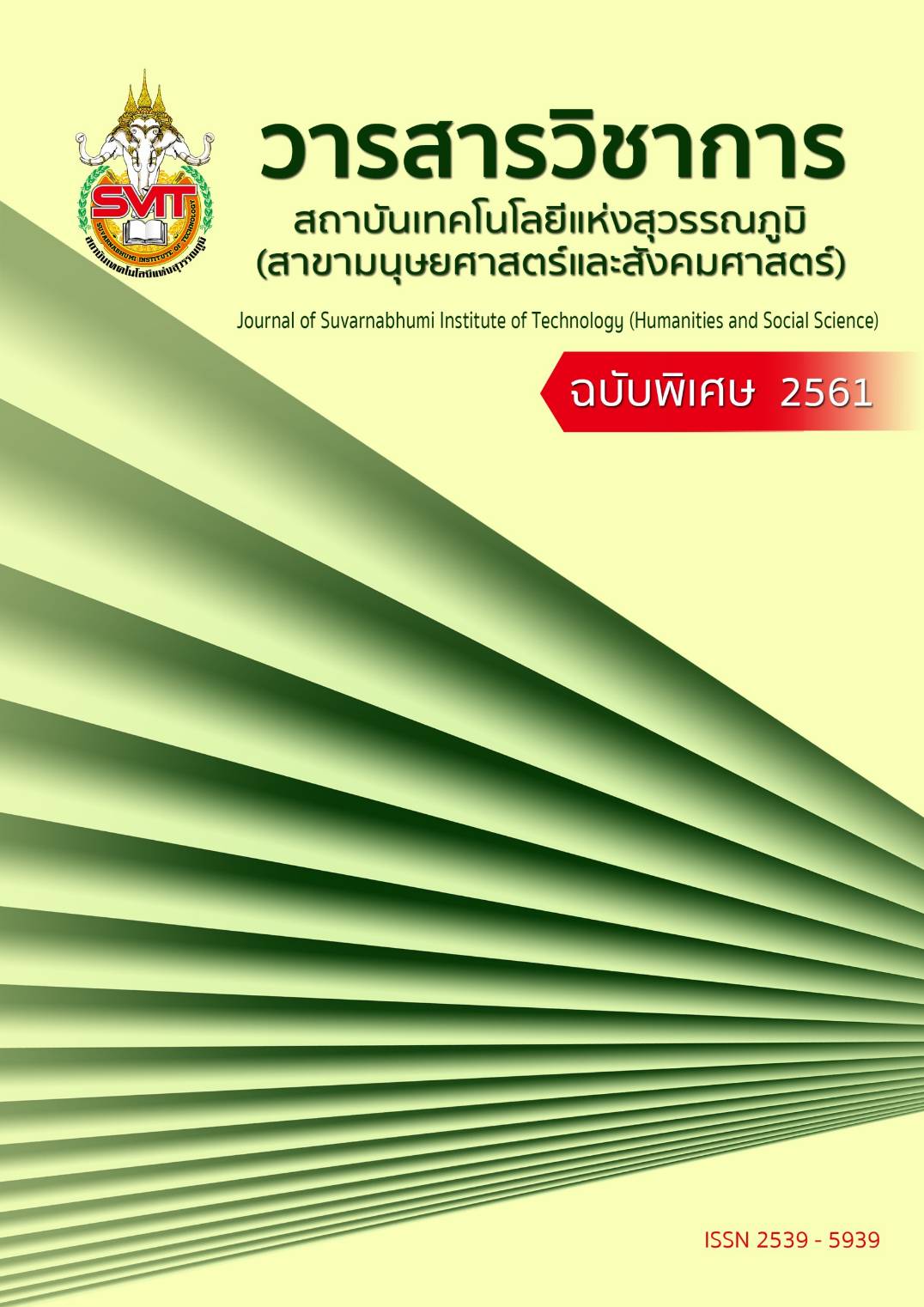GOOD GOVERNANCE IMPLEMENTATION OF SCHOOL ADMINISTRATORS UNDER PATHUMTHANI PRIMARY EDUCATIONAL SERVICE AREA OFFICE 1
Abstract
This reserach is “ Good Governance Implementation of School Administrators under Pathumthani Primary Educational Service Area Office 1” the aims are to study and find the realationship between good governance implementation of school administrators with personnel management of school administrators under Pathumthani primary educational service area office 1 by the opinion of 328 teachers under Pathumthani primary educational service area office 1 , determined the sample group by Krejcie & Morgan ‘s theory and Stratified Random Sampling with strata of school. The data were collected by questionnaires about good governance implementation of school administrators under Pathumthani primary educational service area office 1 as the opinion of teachers under Pathumthani primary educational service area office 1 by check list , rating scale. To find the reliability and the Cronbach’s alpha coefficient was equaled 0.8839 and collected the data by the statistical chance. The data analyzed were presented in frequency, percentage, mean, standard deviation, and Pearson Product Moment Correlation.
The result study revealed that;
Good governance implementation of school administrators with personnel administration under Pathumthani primary educational service area office 1, the overall had the positive relationship at the low level (r=0.210) by statistically significant difference at 0.05. with the same direction . When considering each factor found that economy factor (X6), the overall had the positive relationship at the low level (r=0.210) by statistically significant with the same direction. Rule of law factor (X1) (r=0.098), virtue factor (X2) (r=0.101), participation factor (X3) (r=0.092) and accountability factor (X1) (r=0.098) and the positive relationship at the low level by no statistically significant with the same direction. Transparency factor was the negative relationship with no statistically significant. (X3) (r=0.017)
The relationship between personnel administrative of school administrators with good governance implementation found that recruitment planning factor (y1) (r=0.227) and enhance efficiency and personnel maintenance factors (y2) (r=0.147) had the positive relationship with the same direction by statistically significant difference at 0.05. The other factor had the relationship at the low level by no statistically significant difference and the same direction.
References
เกรียงศักดิ์ เจริญวงค์ศักดิ์. (2541). “ธรรมรัฐภาคการเมือง, บทบาทภาคีเมือง”. (สารวุฒิสภา2541),หน้า 18.
คณะกรรมการข้าราชการพลเรือน, สำนักงานการสร้างระบบบริหารกิจการบ้านเมืองและสังคมที่ดี.(2542). เอกสารประกอบการประกอบการประชุมประจำปีระหว่างส่วนข้าราชการกับ สำนักงานคณะกรรมการข้าราชการพลเรือน. นนทบุรี: สำนักงานคณะกรรมการข้าราชการพลเรือน.
ดุจดาว จิตใส. (2554). การใช้หลักธรรมาภิบาลของผู้บริหารกับการบริหารงานบุคคลในสถานศึกษา สังกัดเทศบาลกลุ่มการศึกษาท้องถิ่นที่ 5. วิทยานิพนธ์ปริญญาศึกษาศาสตรมหาบัณฑิต. สาขาวิชาการบริหารการศึกษา. มหาวิทยาลัยศิลปากร.
วีรยุทธ ชาตะกาญจน์. (2552). เทคนิคการบริหารสำหรับนักบริหารการศึกษามืออาชีพ. กรุงเทพฯ: สำนักพิมพ์จุฬาลงกรณ์มหาวิทยาลัย.
สำนักงานเขตพื้นที่การศึกษาประถมศึกษาปทุมธานีเขต 1. [ออนไลน์]. (2560). ข้อมูลการบริหาร. เข้าถึงจาก http://www.pathum1.go.th/ วันที่ค้น 8 มิถุนายน 2560
สำนักงานเลขาธิการสภาการศึกษา. (2554). ยุทธศาสตร์การพัฒนาคุณภาพการศึกษา:ระเบียบวาระ แห่งชาติ (พ.ศ. 2551-2555). กรุงเทพฯ: พริกหวานกราฟฟิค.
สำนักบริหารงานคณะกรรมการส่งเสริมการศึกษาเอกชน. (2545). แผนพัฒนาการศึกษาเอกชนฉบับที่ 9 (พ.ศ. 2545 - 2549), กรุงเทพมหานคร: กระทรวงศึกษาธิการ.
อรทัย แสงทอง. (2551). “หลักธรรมาภิบาลกับการบริหารสถานศึกษาสังกัดกรุงเทพมหานครกรณีศึกษาสถานศึกษาในเขตตลิ่งชัน”. ปริญญาพุทธศาสตรมหาบัณฑิต รัฐประศาสนศาสตร์ บัณฑิตวิทยาลัย มหาวิทยาลัยมหาจุฬาลงกรณราชวิทยาลัย.
อรพินท์ สพโชคชัย. (2541). “สังคมเสถียรภาพและกลไกประชารัฐที่ดี”. รายงานทีดีอาร์ไอ, ฉบับที่ 20 (มกราคม 2541).
อานันท์ ปันยารชุน. (2542). “ธรรมาภิบาลในการบริหารวิทายาลัย”. สัมมนาวิชาการประจำปี 2542 ที่ประชุมประธานสภาอาจารย์มหาวิทยาลัยทั่วประเทศ, (คณะครุศาสตร์: จุฬาลงกรณ์มหาวิทยาลัย อัดสาเนา, 2542), หน้า 7.
อาภัสสรี ไชยคุณนา. (2542). การบริหารงานบุคคล. คณะครุศาสตร์ สถาบันราชภัฏเชียงใหม่.
อัจฉรา โยมสินธุ์. (2543). บริษัทภิบาลกลยุทธ์ธุรกิจแบบยั่งยืน. วารสารนักบริหาร, ปีที่ 21, (2543). หน้า 34 - 35.
อุทัย หิรัญโต. (2543). หลักการบริหารงานบุคคล.กรุงเทพมหานคร: โอเดียนสโตร.
อุษณีย์ จิตตะปาโลและนุตประวีณ์ เลิศกาญจนวัติ. (2548). การบริหารงานบุคคลระดับประกาศนียบัติรวิชาชีพชั้นสูง (ปวส). กรุงเทพมหานคร: ศูนย์ส่งเสริมวิชาการ.
อำนวย แสงสว่าง. (2544). การจัดการทรัพยากรมนุษย์. พิมพ์ครั้งที่ 2. กรุงเทพมหานคร: ทิพย์วิสุทธิ์.
Krejcie, Robert B; & Morgan, Daryle W. (1970, Autumn). “Determining Sample Size For Research Activity,” in Journal of Education and Psychological Meaurement. Vol. 30 (No.3): P. 608.
Downloads
Published
Issue
Section
License
บทความที่ได้รับการตีพิมพ์เป็นลิขสิทธิ์ของวารสารวิชาการ สถาบันเทคโนโลยีแห่งสุวรรณภูมิ
ข้อความที่ปรากฏในบทความแต่ละเรื่องในวารสารวิชาการเล่มนี้เป็นความคิดเห็นส่วนตัวของผู้เขียนแต่ละท่านไม่เกี่ยวข้องกับสถาบันเทคโนโลยีแห่งสุวรรณภูมิ และคณาจารย์ท่านอื่นๆในสถาบันฯ แต่อย่างใด ความรับผิดชอบองค์ประกอบทั้งหมดของบทความแต่ละเรื่องเป็นของผู้เขียนแต่ละท่าน หากมีความผิดพลาดใดๆ ผู้เขียนแต่ละท่านจะรับผิดชอบบทความของตนเองแต่ผู้เดียว





